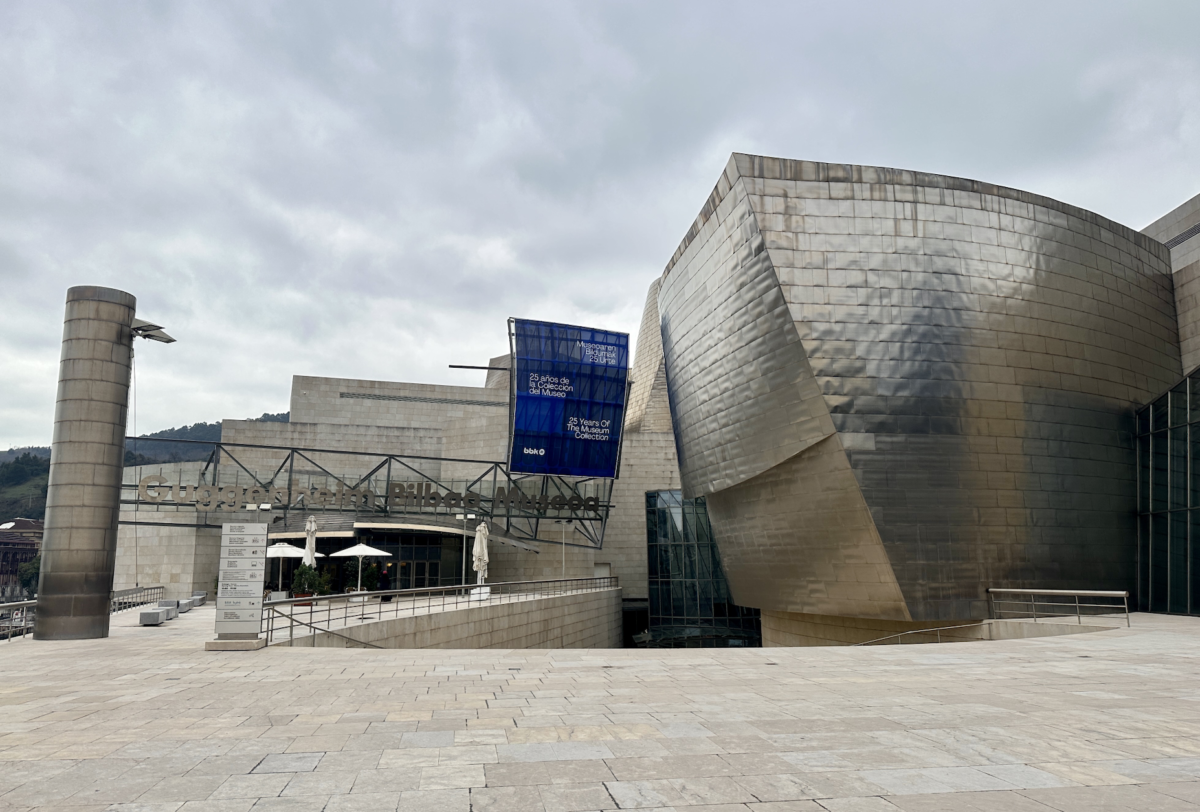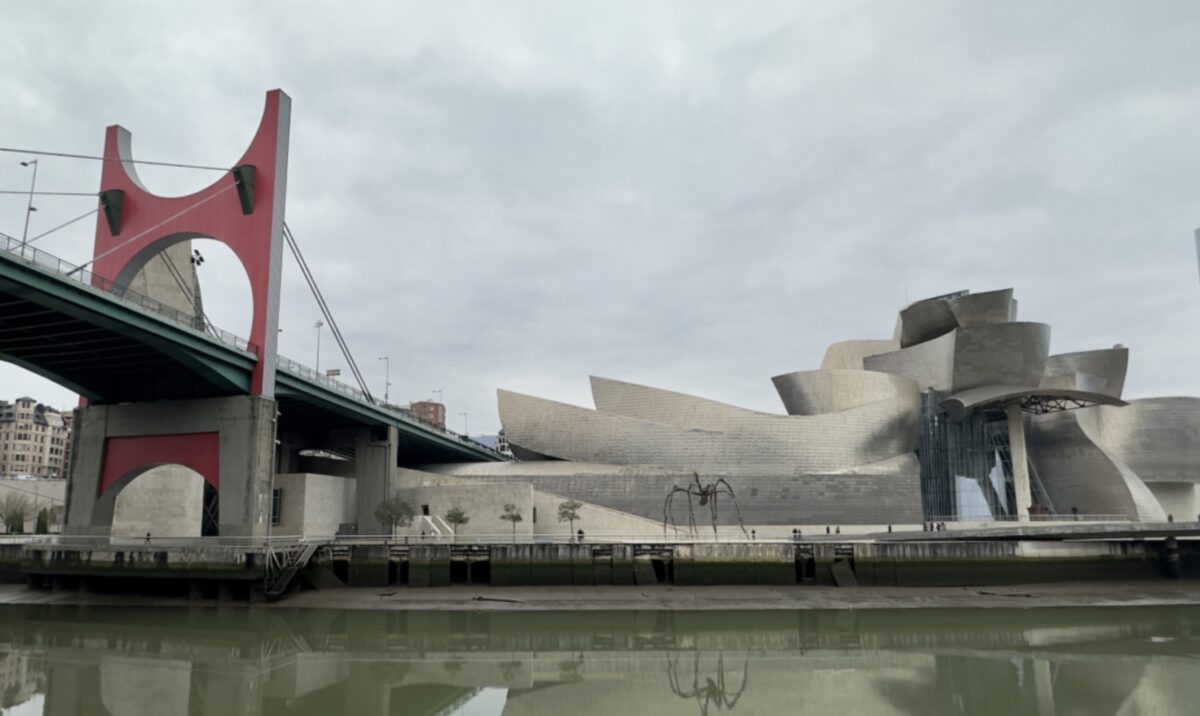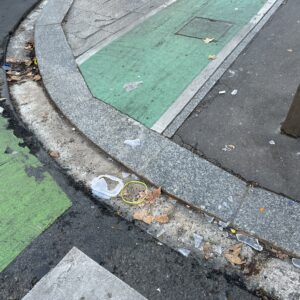— This post is part of BikePortland Staff Writer Taylor Griggs’ trip through Europe. See previous dispatches here.
Bilbao’s renewal was accompanied by a new public transit networks that spread all around the city as well as a citywide commitment to biking and walking infrastructure.
The Spanish city of Bilbao is home to about 350,000 residents, is the biggest metropolis in northern Spain’s Basque Country, and its natural beauty and unique history should be attractive to European travelers looking for something a little different. But it’s the armchair urbanists who will really find a treasure trove of riches in Bilbao.
Alright, maybe I’m just late to the game. After all, Bilbao is well-known enough amongst city planning aficionados to have an architectural concept named after it. The “Bilbao Effect” is a term coined after the 1997 construction of the Guggenheim Museum Bilbao structure: an eye-catching and critically-renowned piece of contemporary architecture that launched designer Frank Gehry into “starchitect” status à la Frank Lloyd Wright (who, of course, designed the famous Guggenheim building in New York).
While the Guggenheim Bilbao is notable for its world-class contemporary art collection, it’s the building that really sold it as an attraction worth traveling to Basque Country for. This is exactly what Bilbao politicians wanted when they appealed to the Guggenheim Foundation to build their next museum in their city, considering it their one great shot at revitalization after years of economic turmoil. And it worked, heralding substantial urban development projects like a robust Metro and tram system, beautiful parks and public spaces and more. But was there a cost?
A 2017 Guardian retrospective on the Gehry Guggenheim building includes a quote conveying the architect’s unease upon seeing his bright, extravagant building in Bilbao for the first time: “I went over the hill and saw it shining there. I thought: ‘What the fuck have I done to these people?”



I started learning about Bilbao in bits and pieces only recently, when my sister moved here to teach English for a year. I had never given much thought to visiting Basque Country, and I was very surprised to hear about how prevalent Basque culture and language is in this city.
When the Guggenheim opened in 1997, some Basque separatists violently protested. Other detractors thought of the museum as an example of American globalism, calling it “McGuggenheim.” Guggenheim naysayers feared that Bilbao’s shiny new tourist attraction and subsequent urban renewal would come at their their city’s authenticity, affordability and perhaps even the future possibility of an independent Basque Country.
From what I can tell, however, the consensus now is that the museum had a positive effect on the city, including for its Basque population. But this is only because Bilbao’s government worked hard to make sure the entire city was able to reap the Guggenheim rewards and its impact wasn’t isolated to a small, touristy area of the city where visitors would stay. If not done thoughtfully and with long-term planning, big tourist installments like this can wreak complete havoc on a city’s inhabitants — think what can happen in short-sighted cities after they host the Olympics.
Closer to home, debates about gentrification and urban renewal projects play out on a smaller scale all the time. The discourse can be hard to keep track of. (For instance: I have no idea what the temperature is on Portland’s new Ritz-Carlton, and at this point I’m too afraid to ask.) People whose worldviews are otherwise aligned can find themselves in uproarious arguments (usually on Twitter) about whether or not luxury condos or new fine dining restaurant establishments are useful to solving the affordable housing crisis or revamping Portland’s economy.
What I’ve learned from Bilbao is that a city is worth a lot more than its most “impressive” structure. It’s going to be tempting to use the existence of new luxury buildings or tourist attractions as a “gotcha” against accusations that Portland is dying, but we’re not going to get very far with that. To me, Portland’s joie de vivre is best embodied by grassroots community activities like Pedalpalooza, the Secret Roller Disco and even the fledgling local arts movement happening at the Lloyd Center.
Like I mentioned, Bilbao’s renewal was accompanied by a new public transit networks that spread all around the city as well as a citywide commitment to biking and walking infrastructure. Now, this city is topping national lists for its high pedestrian mode share (62% of all trips are taken on foot!) encouraged by the government with carfree streets in the city center and gorgeous pedestrian bridges. Bilbao isn’t necessarily known for its bike-friendliness, but I’ve been impressed by the grade-separated bike path network extending throughout its neighborhoods. If Portland’s so-called “rebirth” came with a similar move away from car infrastructure — a strategy with proven economic benefits — I think we could have a similar trajectory.
In Bilbao, beauty extends far beyond Gehry’s building. If the Guggenheim’s titanium panels — and even the Jeff Koons’ ‘Puppy’ installation on the lawn — were to suddenly disappear without a trace, the city would still be worth visiting. More importantly, it would still have resources for the people who actually call this place their home. That’s the part of the “Bilbao Effect” we need to emulate. Of course, the world-class, deconstructionist movement architecture and access to famous contemporary art is cool, too…but it’s not everything.






Thanks for reading.
BikePortland has served this community with independent community journalism since 2005. We rely on subscriptions from readers like you to survive. Your financial support is vital in keeping this valuable resource alive and well.
Please subscribe today to strengthen and expand our work.
Bilbao was one of the best cities I visited while I was studying in Spain a few years ago. The first time I visited was with a big group of US students over a weekend and it was the first time that many had really walked around a city in a way that felt comfortable. I also loved all the greenery and proximity to the ocean via transit. It was all so amazing I made a second trip with one of my best friends for her birthday, just to show her all of the amazing things, including the museum.
One place I’d recommend if you haven’t already visited is the Azkuna Zentroa, a quick walk from the Guggenheim. It’s a little cavernous but it’s also one of the most interesting pieces of urbanism I’ve ever come across. I spend a lot of time thinking what it would take to bring something like that to Portland in a way that would work for the community.
Roanoke Virginia (pop 100,000) has one too: https://www.google.com/maps/@37.2724334,-79.9376183,3a,75y,299.14h,91.5t/data=!3m6!1e1!3m4!1stRZGA80t0-rREaj8wlnXBg!2e0!7i16384!8i8192
It is lower-income working class people*, rent-burdened people, and especially severely-rent-burdened people who face an affordable housing crisis (e.g. housing insecurity)*. The twisting of this chronic humanitarian crisis into one where affordability is re-coded as a lack of sufficiently “nice” housing for Portland’s upper income quintiles is the primary, if not only, cause of this argument.
*especially those who face financial burdens that are not adequately accounted for by HUD’s grossly simplistic and cruel definitions.
Taylor, great topic for a new discussion. Important for Portland to move past its “Portland Plywood” phase …one that many nationally still think Portland is still under attack on every urban block.
Not to talk everyone out of the discussion: It might be pretty difficult for Portland to reap real rewards from a “Bilbao” type investment [multifaceted infrastructure vs just ‘startechure’…like the isolated dysfunctional Rose Quarter] these days given that the “Portland Process” is pretty much broken, needs a strong effective mayor, AND would need to address past errors of process (rip the bandaid / scab off to start the healing BEFORE working on ‘PTown NXT’) before a major design rebirth to occur. There is no foundation yet to build solidly on.
My fading memory of the preBilbao era…Spain and this region of Spain needed a lot of help economically and infrastructure wise as it emerged from decades of dictatorship, economic malaise and to full integration into the EU. Plus the country learned about renewal through the 1992 Olympics (Barcelona) and could build on that experience.
I was in Barcelona when it was announced that they would get the Olympics. In the street actually, it took me a while to figure out why everyone was cheering.
I remember having lunch with a stranger, a polished middle-aged man. He was telling me how poor Spain was, and I said, “but everyone is so well-dressed.” And he said, “if you can’t afford to go to school, if you can’t afford a place to live, it leaves a lot of money for clothes.”
I like the message of this–at least the one I get–that cities shouldn’t let themselves get seduced by the allure of creating expensive, attention-getting projects, because it’s the more mundane things that focus on improving residents’ daily lives that are most important in making a city successful.
“The Bilbao Effect” has more accurately been called “The Bilbao Anomaly”, because so many cities have tried to emulate Bilbao and ended up with expensive, dated, failing museums and similar projects.
Here, it’s easy to forget that the Portland Building was the most eagerly anticipated, discussed building in world architecture when it opened. That fizzled quickly.
The lesson I’d like to see applied specifically to Portland transportation is the same–to resist getting enamored with expensive, visible projects and focus on the more mundane, smaller things. ODOT should focus on making city highways safe over massively expensive freeway projects, TriMet should focus on better bus service versus new Light Rail lines, PBOT should focus on sidewalks and crosswalks over expensive bridges, etc.
In spite of every effort to do otherwise, Oregon hasn’t actually built a major new freeway since 1992. Sam Adams did in fact delay paying the bonds on the Sellwood Bridge and used the money to build sidewalks in East and SW Portland instead.
The Portland Building was supposed to be twice as tall and look like a guy with suspenders on, but due to a tightwad city council and cost overruns, you got the building now there. It wasn’t even up to earthquake specs of that time (1986).
ODOT is currently focusing on two massively expensive freeway projects–the widening in NE Portland, and the new bridge. Just the widening one is approaching a billion dollars. A fraction of that budget could go a long way improving safety on ODOT highways in the city.
That’s interesting about Sam Adams. What I was thinking of specifically were the several non-vehicular projects Portland has done in the last several years–the Flanders and Blumenauer bridges, Tilikum Crossing and the tram. I like them all, and the case can be made that all should have happened. On the other hand, the budget of just one could have built a lot of safer crossings and sidewalks. But building those doesn’t have the allure of cutting the ribbon on a new bridge.
You’re right that the Portland Building that was built was compromised in many ways. That’s the point, that for every Bilbao (which actually isn’t known for being a very good place to display art) there are several Portland Buildings–projects that don’t live up to their hype and are soon forgotten other than as warnings of what can go wrong.
One of the ironies about Portland is that the very plain Commonwealth Building at 421 SW 6th Ave is frequently featured in many architecture books as a particularly fine example of modern 1960s office design (“modern” as an architectural style, not as in new.)
Any freeways through the heart of Bilbao? Frankfurt am Main, no beauty, has a dozen museums along the opposite side of its river; PDX has 12 lanes of freeway. A huge mistake in the 60’s that still kills life in the city. And then there is the Rose Quarter, cut off by that same freeway; no wonder its been a loser for so many years. Long past time to de-commission urban freeways and build more housing!
Taylor, I’ve really enjoyed reading your trip dispatches and viewing your photos. I think you’re a good photojournalist!
I agree with your “closer to home” comments. Over the years during my photowalks, with few exceptions (as I noted on Jan. 24), I’ve tried to capture scenes that show Portland’s joie de vivre. I want to remain clear-eyed, but I’ll leave it to the WT? and other peeps to post their ongoing scenes of decay and despair. I say more here, under my Portland(ia) Theme.
Bilbao is huge on walking — about 62% of all trips are made on foot.
This is an impressive stat. Portland, let’s catch up!
What’s funny is we had this, we literally had Portland known as a national destination for food, wine, outdoors, etc. and a very small group of residents and elected “leaders” ruined it. The last five years it went from hearing “wow, Portland is such a cool place to live, you must love it” to “wow, is Portland as bad as it looks on the news, we were going to go there, but just went to Napa/Sonoma, Colorado, Utah, California instead.”